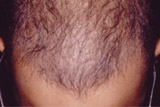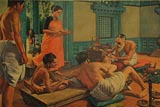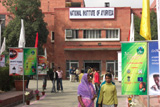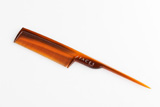Āyurveda
An evaluation of karañjādi taila and guñjā phala lepa in the management of khalitya
Editor’s note
Each age of mankind has its own illuminations and discoveries to make. While the cycles of time may move them out of sight for a while, often we return back to these lost truths that had been hastily discarded or summarily dismissed. Now that we return to a new age of longing and finding, it is natural that man's gaze will turn towards all that has been left behind and rediscover the old in terms of the new. If Āyurveda bears the pride of a unique legacy, it must also bear the burden of re-examining its old truths in the light of modern methods, so as to validate them in the language and through the methods that modern mind understands, since it is conversant with these alone. The article below is a good example how formulas are being examined and validated through modern statistical methods.
Abstract
This study was conducted on 60 clinically diagnosed and confirmed patients with Khalitya (alopecia). Patients having Khalitya due to other diseases or as side-effects of a drug were not registered. The trial was conducted with the aim of evaluating the role of karañjādi taila, and guñjā phala lepa in the management of Khalitya.
It was observed that there was significant improvement in hair-fall and new growth of hair also took place over the bald area after the application of karañjādi taila and guñjā phala lepa.
Introduction
Hair-fall or Khalitya is a physiological phenomenon if it occurs after the mid-forties, but is considered a disease if it arises earlier. Modern-day lifestyles, eating habits, pollutants, stress, decreased immunity, hormonal imbalance, faulty hair care, etc. have increased the incidence of premature greying and loss of hair. Different types of oils (chemical oils), shampoos, soaps and pharmaceutical promotions in the name of saundarya prasādhana for promoting hair growth actually make the condition worse. This study has been undertaken to find a more promising remedy.
Khalitya, as described in Āyurvedic texts, has features quite similar to that of alopecia. Alopecia, which is the medical description, literally means ‘loss of hair’ and can have many causes.
Pathophysiology according to Āyurveda
In the pathogenesis of Khalitya, Suśruta explains the involvement of all doṣas in succession. Firstly vāta and pitta are deranged, affecting the (romakūpa) hair roots leading to a gradual hair-fall. When kapha starts filling the pores of the hair roots, it prevents fresh growth. This leads to baldness.
Material and method
The aim of this study was to assess the upaśayatmaka effect of karañjādi taila and guñjā phala lepa for patients with Khalitya.
Number of patients
For this therapeutic study, thirty patients were short-listed in each group — A and B. Eight patients were omitted from the study because they did not fulfill the required clinical guidelines.
Selection of cases
Patients coming to the O.P.D. and I.P.D. of the National Institute of Āyurveda were accepted into the study on the basis of the following criteria:
i. Inclusion criteria• Age group: 15-40 years
• At least 100 hairs falling daily
• Genetic predisposition
• Individuals below 15 and above 40 years of age
• Use of hair dye or any chemical
• Dandruff-associated hair-fall
• Hair-fall due to any prolonged debilitation.
Patients who could not follow the treatment or those who developed hypersensitivity and other side- effects to the drug discontinued.
Grouping of patients
Patients included in the study were randomly divided into two groups. Group A was given karañjādi taila and Group B was given guñjāphala lepa
Mode of applicationGroup A
Patients in this group were told to massage their scalp at night with the tips of their fingers gently for about 10-15 minutes, using 10-20 ml of the oil, according to their hair density. The oil was to be allowed to remain overnight and patients were asked to wash it off the next morning with a mild shampoo or ordinary bathing soap.
Group B
Patients from this group were instructed to apply the guñjā phala lepa twice a week. They were given guñjā phala cūrṇa and instructed to make the lep with water – neither too thick nor too thin. They were then asked to apply the lepa over the bald area, allow it to stay on the scalp to dry and wash it off after 3-4 hours with shampoo or soap.
Follow-up
Patients from both groups were instructed to report fortnightly during the trial period which took three months.
Assessment criteria
All patients were examined fortnightly during the trial treatment. Assessment was based on hair-fall. For this purpose, scores were given according to the severity of hair-fall before and after treatment.
Details of the scoring adopted for this purpose are stated below:
Scoring pattern for hair-fall |
Grade |
| No hair-fall | 0 |
| Hair-fall when combing wet hair or after oiling hair and combing | 1 |
| Hair-fall while washing the hair and normal combing | 2 |
| Hair-fall without combing | 3 |
Ingredients
No |
Name |
Botanical name |
Part used |
1 |
Karañja |
Pongamia pinnata |
Fruit |
2 |
Citrāka |
Plumbagozeylanica |
Root |
3 |
Jāti |
Jasminum officinale |
Leaves |
4 |
Karavīra |
Nerium indicum |
Leaves |
5 |
Tila taila |
Sesamum indicum |
Seeds |
In the preparation of karañjādi taila, a method has been followed as per Sharangdhar.
Result table showing the pattern of reduction of hair-fall in Group A.
Symptoms |
No. of patients |
Mean |
Diff. |
% of Change |
±SD |
SE |
T |
P |
Results |
|
BT |
AT |
|||||||||
| Frontal Region | 30 |
2.43 | .076 | 1.66 | 68.31 | 0.54 | 0.10 | 16.69 | <0.001 | Highly significant |
| Temporal Region |
9 |
0.36 | 0.03 | 0.33 | 91.67 | 0.54 | .010 | 3.34 | <0.05 | Significant |
| Parietal Region |
24 |
1.06 | 0.23 | 0.83 | 78.03 | 0.59 | 0.10 | 7.70 | <0.001 | Highly significant |
| Occipital Region |
14 |
0.50 | 0.16 | 0.33 | 66.00 | 0.47 | 0.08 | 3.80 | <0.001 | Highly significant |
After application of karañjādi taila patients in Group A showed statistically highly significant (P < 0.001) reduction in hair-fall in the frontal, parietal, and occipital regions of the scalp. In the temporal region statistically significant (P < 0.05) reduction in hair-fall was observed in this group.
Pattern of reduction of hair-fall in Group B
Symptoms |
No. of patients |
Mean |
Diff. |
% of Change |
±SD |
SE |
T |
P |
Results |
|
BT |
AT |
|||||||||
| Frontal Region | 29 |
2.66 | 1.33 | 1.33 | 50.00 | 0.60 | 0.11 | 12.04 | <0.001 | Highly significant |
| Temporal Region |
6 |
0.20 | 0.10 | 0.10 | 50.00 | 0.30 | 0.05 | 1.79 | <0.05 | Not significant |
| Parietal Region |
20 |
1.13 | 0.43 | 0.70 | 61.94 | 0.74 | 0.13 | 5.11 | <0.001 | Highly significant |
| Occipital Region |
7 |
0.30 | 0.06 | 0.23 | 76.66 | 0.43 | 0.07 | 2.97 | <0.01 | More significant |
After application of guñjā phala lepa in Group B, patients showed statistically highly significant (P < 0.001) reduction in hair-fall in the frontal and parietal regions, while non significant results ( P > 0.05) were observed in the temporal region and more significant (P < 0.01) were noticed in the occipital region.
Comparison in reduction of hair-fall in Group A and Group B

a – For Group A
b – For Group B
F – Frontal
T – Temporal
P – Parietal
O – Occipital
Abbreviations used:
Fa = frontal region after treatment
Fb = frontal region before treatment
Ta = temporal region after treatment
Tb = temporal region before treatment
Pa = parietal region after treatment
Pb = parietal region before treatment
Oa = occipital region after treatment
Ob = occipital region before treatment
Discussion
We reviewed the literature about Khalitya in all available Āyurvedic texts and then formulated the nidāna according to the lakṣaṇ of the disease with the help of the concept given in the Sūtrasthāna. According to this, all the āhāra and vihāra (diet and lifestyle) which aggravate the vāta and pitta (primary) become the nidāna of Khalitya as mentioned by Caraka. As kapha along with śonnita (rakta) fill the orifice (romakūpa) to cause baldness not only the nidāna but the whole nidānapañcaka was derived from the commentaries and thesis available on related subjects.
In the first drug, karañja, citrāka, jāti, karavīra were the main constituents which are kaṭu, vipaki and uṣṇa vīrya. By virtue of these properties, it is kaphavāta śāmaka. Additionally cameli is tikta, kaṣāya in rasa, so it is pittaśāmaka too. Tila taila is madhura uṣṇa and tridoṣa śāmaka karavīra and citrāka also possess the properties of sveda janana and karañja is mainly used in skin disorders and cameli rakta prasādana.
The second drug taken for the trial was guñjā phala in the form of powder. The seed of guñjā is kaṭu uṣṇa so it is vāta kapha śāmaka, keshya, kuṣṭgna. Again the mode of action of this drug is supposed to be due to kapha vāta śamana. As mentioned earlier in the karañjādi taila discussion, kapha fills the romakūpa to obstruct and prevent the growth of new hair. vāta is the initial doṣa which transports the other doṣas. By virtue of its rukṣa guṇa, kapha is decreased and growth of new hair facilitated.
Conclusion
Results of this study are very encouraging but the study was conducted on a small group of patients, so a trial should be conducted on a larger sample size.
Bibliography
1. Acarya J.T. Caraka saṁhitā. Varanasi; Chaukhambha Sanskrit Sansthan, 2001.
2. Shastri, K., Ambika Datta. Suśruta saṁhitā. Varanasi; Āyurveda Taṭva Sandīpika Hindi commentary, Chaukhambha Sanskrit Sansthan.
3. Shastri, P. Sharangadhara saṁhitā. Varanasi; Chaukhambha Orientalia – 2002.
4. Shastri, K. Shri Ambika Datta. Bhaiṣajya Ratnāvali. Varanasi; Chaukhambha Sanskrit Sansthan.
5. Database for medicinal plants used in Āyurveda, Volume 2. New Delhi; CCRAS, Dept. of JSM & H, Ministry of Health & Family Welfare, G.O.I., 2001.
6. Wealth of India, Volume 1A. New Delhi; Raw Material, Publication & information Directorate, New Delhi.
7. Shastri, K. Caraka saṁhitā, Sūtrasthāna (Hindi commentary). Varanasi; Chaukhambha Bharti Academy.
8. Ed. Yadavji. Caraka saṁhitā (Chakrapani commentary). Varanasi; Cikitsasthana, Chaukhambha Sanskrit Sansthan, 2001.
9. Thakar Dr., Jamnagar, B.B.U. Methodology of research in Āyurveda.
10. Dwarkanath, C. Introduction of Kāyacikitsā. Mumbai; Popular Book Dept.
11. Textbook of Medical Physiology, Guyton Hall, 1989.
12. Cowdary, S. K. Concise Medical Physiology. Kolkata; New Central Book Agency (Pvt. Ltd.).
13. Mahajan, B.K. Methods of biostatistics for medical students and research workers. New Delhi; Taypee Brothers Medical Publishers.
14. http://www.indianmedicine.nic.in
Dr. Dharmpal Bhatt is M.D. Scholar and Dr. S. P. S. Jaijania Associate Professor at the Postgraduate Dept. of Shahir Kriya, National Institute of Ayurveda, Jaipur.
Share with us (Comments,contributions,opinions)
When reproducing this feature, please credit NAMAH,and give the byline. Please send us cuttings.




